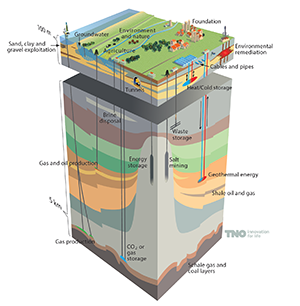The deep subsurface of the Netherlands is used intensively and offers a wide range of options for producing and storing resources and energy. These opportunities have become increasingly obvious as a result of the intensive exploration for and production of fossil fuels since the 1950s. The huge data volumes acquired (through 2D and 3D seismic surveys and in deep wells) now provide a unique understanding of the architecture and properties of the deep subsurface. Most of these data are publicly accessible and have now been used for quite some time to systematically construct 2D maps and 3D models reflecting the architecture, composition and dynamic behaviour of the subsurface. These models form the basis for assessing the various potential uses.
Carrying out mining activities in the (deep) subsurface can cause several effects around the earth's surface (see mining effects). Possible effects occur locally in the vicinity of an activity. Preventive or mitigating measures should be defined in the production (winnings) plan. These plans may be found using the data center. Due to the predominantly local nature of these effects this information is not useful to display in regional oriented cards
The following links provide access to regionally focussed maps and explanatory notes to assess present and future potential uses currently identified for the deep subsurface. Up-to-date information on the production of and exploration for resources in existing licence areas can be viewed via this link: Activities.TNO is also required by the Ministry of Economic Affairs to publish an annual report on this subject: Natural resources and Geothermal energy in the Netherlands (Delfstoffen en Aardwarmte).
- Hydrocarbons: General geological setting and basic conditions; data on existing oil and gas fields; potentially prospective areas for exploration for new conventional and also unconventional (e.g. shale gas) accumulations.
- Geothermal energy: General geological setting and basic conditions; data on existing exploration for and production of geothermal energy; various forms of geothermal energy; areas that are prospective for exploration for and development of geothermal energy applications.
- Rock salt: General geological setting and basic conditions; data on existing exploration for and mining of rock salt; various salt mining techniques; areas that are prospective for exploration for and development of salt mining.
- Storage: General geological setting and basic conditions; various types of storage; existing storage facilities, and areas and strata that are prospective for developing various forms of storage.

